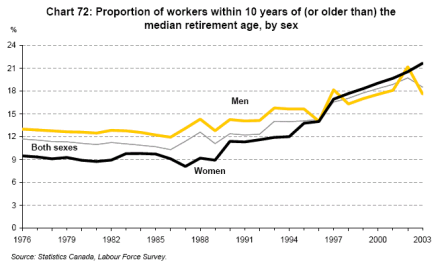

|
 |
Table of contents > Section M - The aging population and retirement >
Workers within 10 years of retirement age
A higher proportion of workers is nearing retirement than ever before
- From 1976 to 1986, the proportion of workers nearing retirement—those within 10 years of (or older than) the median retirement age—dropped slightly from 12% to 10%. During this period, the median age at retirement hovered around 65 years. However, the retirement age fell subsequently, from 64.6 years in 1986 to 60.6 years in 1997. At the same time, the proportion of workers within 10 years of the median retirement age—the near-retirement rate—increased by 7 percentage points to 17%.
- From 1997 to 2002, the proportion of workers nearing retirement grew steadily, increasing 3 percentage points to a high of 20%. During this period, the oldest baby boomers entered the group of workers approaching retirement, which had a greater influence in the rise of the near-retirement rate than the median age at retirement at that time (which fluctuated around 61 years). From 2002 to 2003, the proportion of workers nearing retirement dropped slightly to 19%, the first decline in more than a decade, as the median age at retirement rose, mostly among men. In 2003, there were 2.9 million workers nearing retirement.
- Long-term trends for men and women are similar. However, the proportion of employed women within 10 years of their median retirement age has, for the most part, been increasing faster than that of men since 1989. The likely explanation is that the median retirement age for women declined much more during this period than for men. A greater proportion of women than men work in the public sector, where employees retire at a younger age than those in the private sector or the self-employed. In 2003, the proportions of workers nearing retirement were 18% for men and 22% for women.
Enlarge chart
|


